Content for TS 23.434 Word version: 19.2.0
0…
4…
5
6…
6.4…
6.5…
6.5.3…
7…
8…
8.2.2…
9…
9.3…
9.3.2.21…
9.3.3…
9.3.6…
9.3.11…
9.3.13…
9.3.14…
9.4…
9.4.6…
9.5…
10…
10.3…
10.3.2.22…
10.3.3…
10.3.7…
10.3.10…
10.4…
11…
11.3…
11.3.3…
11.4…
12…
12.3…
13…
14…
14.2.2.2…
14.3…
14.3.2.20…
14.3.2.40…
14.3.3…
14.3.3.3…
14.3.4…
14.3.4.6
14.3.4.7…
14.3.4A…
14.3.4A.3…
14.3.4A.4…
14.3.4A.6…
14.3.4A.8…
14.3.4A.9…
14.3.4A.10…
14.3.5…
14.3.6…
14.3.9…
14.3.12…
14.4…
15…
16…
17…
18…
A
B…
9.3.3 Event-triggered location reporting procedure
9.3.3.1 General
9.3.3.2 Fetching location reporting configuration
9.3.3.3 Location reporting
9.3.3.4 Update Location reporting configuration
9.3.4 On-demand location reporting procedure
9.3.5 Client-triggered or VAL server-triggered location reporting procedure
...
...
9.3.3 Event-triggered location reporting procedure p. 65
9.3.3.1 General p. 65
The location management server provides location reporting configuration to the location management clients, indicating what information the location management server expects and what events will trigger the sending of this information to the location management server. The decision to report location information can be triggered at the location management client by different conditions, e.g., the reception of the location reporting configuration, initial registration, distance travelled, elapsed time, cell change, MBMS SAI change, MBMS session change, leaving a specific MBMS bearer service area, tracking area change, PLMN change, call initiation, or other types of events such as emergency. The location report can include information described as ECGI, MBMS SAIs, geographic coordinates and other location information.
9.3.3.2 Fetching location reporting configuration p. 66
Figure 9.3.3.2-1 illustrates the procedure for fetching location reporting configuration.
Pre-condition:
- If multicast delivery mode is used, the MBMS bearer being used is activated by the location management server.
- The location management client is aware that the location reporting configuration is available at the location management server.
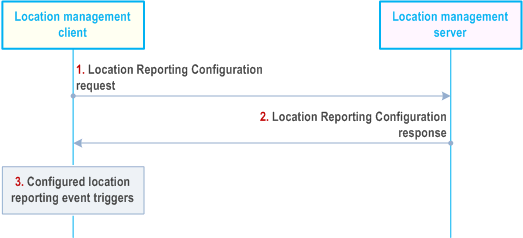
Step 1.
The location management client sends location reporting configuration request message to the location management server.
Step 2.
The location management server sends location reporting configuration message to the location management client(s) containing the initial location reporting event triggers configuration (or a subsequent update) , e.g. minimum time between consecutive reports, SAI changes, access RAT changes, or ECGI changes for reporting the location of the VAL UE. This message can be sent over a unicast bearer to a specific location management client or as a group message over an MBMS bearer to update the location reporting configuration for multiple location management clients at the same time.
Step 3.
The location management client stores or updates the location reporting event triggers configuration. A location reporting event occurs, triggering step 3.
9.3.3.3 Location reporting p. 66
Figure 9.3.3.3-1 illustrates the procedure for location reporting.
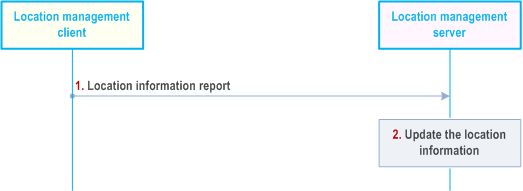
Step 1.
The location management client sends a location information report to the location management server, containing location information identified by the location management server and available to the location management client.
Step 2.
Upon receiving the report, the location management server updates location of the reporting location management client. If the location management server does not have location information of the reporting location management client before, then just stores the reporting location information for that location management client.
9.3.3.4 Update Location reporting configuration |R18| p. 67
The location management server may update the location reporting configuration information and inform the location management client of the update ones at any time by triggering the location reporting configuration update procedure.
Figure 9.3.3.4-1 illustrates the procedure for location reporting configuration update.
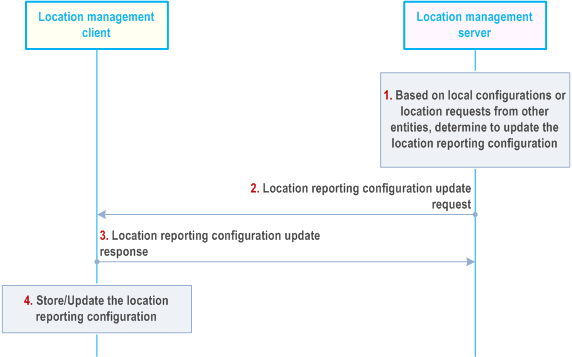
Step 1.
Based on the local configurations or the location information request from other entities (e.g., another location management client, VAL server) or if the VAL server updates the geographical location information of the existing VAL service area ID and there is triggering criteria corresponding to the updated VAL service area ID, the location management server decides to update the location reporting configuration and informs the updated information to the location management client.
Step 2.
The location management server sends location reporting configuration update request message to the location management client(s) which may contain the updated location reporting configuration, e.g. the event triggers, the minimum time between consecutive reports, the requested location access type and positioning methods when VAL UE fetches the UE location report. This message can be sent over a unicast bearer to a specific location management client or as a group message over an MBMS bearer to update the location reporting configuration for multiple location management clients at the same time. If the location reporting trigger from VAL server contains the triggering criteria based on the VAL service area ID, then the location management server converts those triggers into geographical area based triggers while sending it to the location management client.
Step 3.
The location management client(s) reply with location reporting configuration update response to the location management server with the update result.
Step 4.
The location management client stores or updates the new location reporting configuration received in step 2.
9.3.4 On-demand location reporting procedure p. 68
The location management server can request UE location information at any time by sending a location information request to the location management client, which may trigger location management client to immediately send the location report.
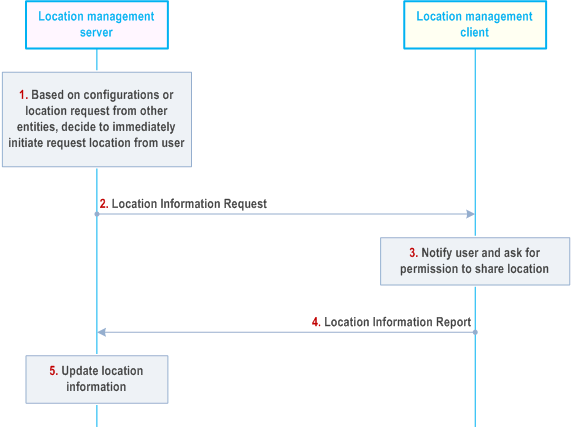
Step 1.
Based on configurations such as periodical location information timer, or location information request from other entities (e.g., another location management client, VAL server), location management server initiates the immediately request location information from the location management client.
Step 2.
The location management server sends a location information request to the location management client.
Step 3.
VAL user or VAL UE is notified and asked about the permission to share its location. VAL user can accept or deny the request
Step 4.
The location management client immediately responds to the location management server with a report containing location information identified by the location management server and available to the location management client.
Step 5.
Upon receiving the report, the location management server updates location of the reporting location management client. If the location management server does not have location information of the reporting location management client before, then just stores the reporting location information for that location management client.
9.3.5 Client-triggered or VAL server-triggered location reporting procedure p. 68
Figure 9.3.5-1 illustrates the high level procedure of client-triggered or VAL server-triggered location reporting.
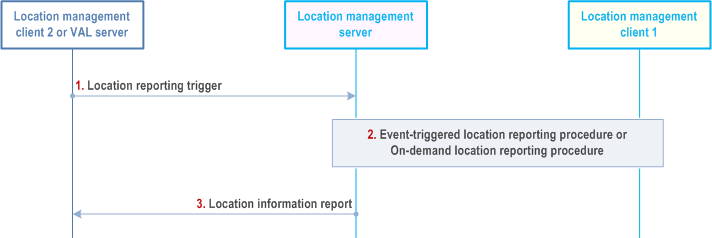
Step 1.
Location management client 2 (authorized VAL user or VAL UE) or VAL server sends a location reporting trigger to the location management server to activate a location reporting procedure for obtaining the location information of location management client 1. The location reporting event triggers e.g. minimum time between consecutive reports, SAI changes, access RAT changes, or ECGI changes for reporting the location of the VAL UE, are included.
Step 2.
Location management server checks whether location management client 2 or VAL server is authorized to send a location reporting trigger. Depending on the information specified by the location reporting trigger, location management server initiates an on-demand location reporting procedure or an event-triggered location reporting procedure for the location of location management client 1.
Step 3.
Once the location information of the location management client 1 is available in the location management server by the on-demand location reporting procedure, a location information report is sent to the location management client 2 or VAL server.